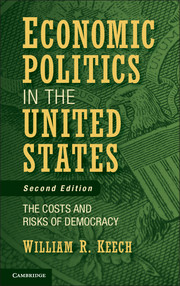Book contents
- Frontmatter
- Contents
- List of Figures and Tables
- Preface to the Second Edition
- Preface to the First Edition
- Part One Introduction
- Part Two Models of Macroeconomic Politics in a Democracy
- Part Three The Sources and Authority of Macroeconomic Goals
- Part Four Institutions and Processes
- 8 Rules, Discretion, and Accountability in the Monetary Policy Process
- 9 Rules, Discretion, and Accountability in the Fiscal Policy Process
- Part Five Conclusion
- References
- Index
8 - Rules, Discretion, and Accountability in the Monetary Policy Process
Published online by Cambridge University Press: 05 June 2014
- Frontmatter
- Contents
- List of Figures and Tables
- Preface to the Second Edition
- Preface to the First Edition
- Part One Introduction
- Part Two Models of Macroeconomic Politics in a Democracy
- Part Three The Sources and Authority of Macroeconomic Goals
- Part Four Institutions and Processes
- 8 Rules, Discretion, and Accountability in the Monetary Policy Process
- 9 Rules, Discretion, and Accountability in the Fiscal Policy Process
- Part Five Conclusion
- References
- Index
Summary
Monetary policy is the control of the money supply and of interest rates to stabilize the economy. For decades, it has been the main instrument of stabilization policy in the United States. Fiscal policy, the use of taxing and spending powers to guide the economy, receded into the background, though it has had a resurgence in the 2000s (Auerbach et al. 2010). Normally, the possible actions available to monetary authorities have to do with the levels of interest rates and the rate of growth of the money supply, which in turn may affect the level of economic activity and the rate of inflation.
Good and successful monetary policy can bring an appropriate balance between economic growth and stable prices, but, of course, the meaning of “appropriate” is contestable. Poor or unsuccessful monetary policy runs two main risks. If the money supply grows much faster than real economic activity, the result will be inflation or even hyperinflation. The opposite risk is that there will not be enough financial liquidity to support the real economic activity that would take place if credit were more readily available. The United States has never experienced hyperinflation, but monetary policy has been at least partly responsible for the sustained increases in price levels since World War II. The second risk was experienced in the banking panics and recessions of the nineteenth and early twentieth centuries, and the Great Depression itself has been attributed to poor monetary policy.
- Type
- Chapter
- Information
- Economic Politics in the United StatesThe Costs and Risks of Democracy, pp. 179 - 204Publisher: Cambridge University PressPrint publication year: 2013



